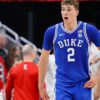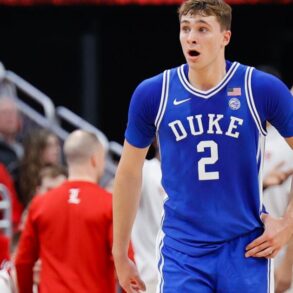Auburn has by far the best resume in college basketball. The Tigers rank No. 1 in every resume metric and have 14 Quadrant 1 wins; Alabama and Tennessee are tied for second with nine apiece.
The quad system has only been around since 2018, so we don’t have a ton of history when it comes to Q1 wins, but 2023 Kansas currently tops the all-time Q1 wins leaderboard with 16. The Tigers have four Q1 games left on their regular season schedule, meaning they could blow by that mark before the regular season ends.
Advertisement
All that means Auburn continues to deserve its No. 1 spot in the polls, but if we were doing a power ranking and not a Top 25 ballot, there’s now a debate. Duke has passed Auburn in the predictive metrics. The Blue Devils are No. 1 at KenPom, No. 1 at BPI, No. 2 at Torvik (Houston is No. 1) and No. 1 at Evan Miya. Duke has only six Q1 wins but seems to have hit a new gear as the Cooper Flagg experience enters the stretch run.
Let’s get to this week’s edition.
Reminder: Below my Top 25, I give nuggets on an unspecified number of teams each week. So when a team appears in the table but not in the text below, that’s why. Scroll on for notes on Duke, Houston, Michigan State, St. John’s, Maryland, Clemson, BYU and Saint Mary’s.
No. 2 Duke
Last weekend in a 106-70 win against Stanford, Duke turned in the fourth-highest efficiency against a high-major in Pomeroy’s database, which dates back to 1997. Then Duke put up a modest (actually, not that modest) 1.31 points per possession at Virginia and then 1.51 PPP in a dominant 110-67 win over Illinois at Madison Square Garden.
That’s an offensive rating of 147 over three games. How’s that sample compare to the best three-game stretches against high-major opponents in Pomeroy’s database? It blows past the previous high of 140 by North Carolina in 2016. Pomeroy said it’s the fourth-best three-game stretch ever in his database, and the top three were all early-season runs against lesser opponents in buy games.
To give a little more perspective of just how ridiculous it is to score this efficiently in three straight games, that 1.47 PPP number is by far better than any single-game output Auburn has had all year, and Auburn is currently the most efficient offense in college basketball history. Adjusted for opponent, the number is even better: 151 points per 100 possessions, per Bart Torvik. These are just silly numbers, and Duke is executing so well that it looks like it’s running its offense against air.
Advertisement
It all starts with the screening. The Blue Devils do a great job of setting up the screen, often set by Khaman Maluach, who is also a terrific roller.
This was my favorite play from Saturday’s rout, and it sums up why Duke is getting whatever it wants:
Nothing is complicated. It’s the execution. This is set up perfectly by Kon Knueppel, who isn’t rushed once he gets the ball and makes sure to engage Illinois big Tomislav Ivisic to set up Maluach. But watch Mason Gillis on the right side of the floor. As soon as he notices where the roll is going to go, he starts lifting up the floor so his man isn’t there to help on Maluach.
Duke is just so in sync right now: very few forced shots, everyone spacing to the right spots and a balanced attacked (seven players reached double figures against Illinois) that makes it so defenses cannot just focus on one or two guys. I wouldn’t be surprised if Duke’s offense passes Auburn’s by next week. The Blue Devils are on a rocket ship, and most of the ACC isn’t equipped to even try to slow them down.
Apologies to Pomeroy. I’ll probably be emailing him next week with another question about the history Duke is making.
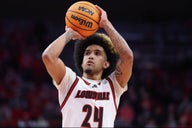
GO DEEPER
To lead Louisville, Chucky Hepburn had to face the losses that fueled him
No. 4 Houston
Houston essentially won the Big 12 this weekend. The Cougars need just one more win to secure at least a share of the league title, up three with four to play. So it’s over.
That means the Cougars will have won their league in six of the last seven years, and the one exception was in 2021 when Houston went 14-3 in the AAC but finished behind Wichita State’s 11-2 record, with the difference in games played due to Covid pauses. Houston went on to win the conference tournament and make the Final Four. Its score differential in league play was far ahead of Wichita State, which went on to lose in the first round of the NCAA Tournament. Had the schedules been balanced, there’s no doubt Houston would have been the champ. There’s a giant asterisk on that year. (Sorry, Shockers.) The larger point: Kelvin Sampson should have seven consecutive regular-season titles.
Advertisement
And it’s time to rewrite a narrative. The Cougars dominated the American, but the consensus was they wouldn’t have as easy of a time in the Big 12. Now they’re two for two. During that dominant run in the American, they had the league’s best offense and defense three of those years; they’re on track to do the same this season in the Big 12. In the history of the Big 12, that has happened only eight times: Kansas has done it seven times (1997, 1998, 2002, 2008, 2010, 2014 and 2020) and Oklahoma State did it once (2004). Somehow Houston is treating the Big 12 like it’s the AAC. In fact, the Cougars’ in-conference 22.1 efficiency margin is higher than it was in three of their final five years in the American.
Had the 2020 NCAA Tournament happened, Houston would be on track to make its eighth straight NCAA Tournament. No program has won more games over those eight years, no program has won more regular-season conference titles (once Houston ties Gonzaga with this Big 12 title) and you could argue no coach has been better. (Dan Hurley has the back-to-back national titles but just one league title over that stretch, and for two of those years he was in Sampson’s league.)
All that’s missing from this run for Sampson is a national title, but whether that comes or not, this is a legendary stretch at a school that was a has-been, irrelevant in the sport with no sign of hope. Sampson changed everything, and now the Cougars are a national power. Turns out, it had nothing to do with their league.
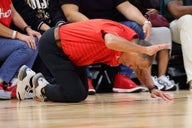
GO DEEPER
Houston is still college basketball’s toughest team. But Kelvin Sampson made a tweak
No. 7 Michigan State
Since a 1-3 stretch had some wondering whether Michigan State’s success had been a product of its schedule — gulp, guilty — Tom Izzo’s team has three straight wins over KenPom top 25 teams.
How many KenPom top 25 wins did Sparty have before this run? One.
Three of the regular season’s final four games also qualify, and it appears the competition is bringing the best out of the Spartans.
Another thing that helps: Dunks!
Advertisement
Michigan State is one of the most efficient teams on shots at the rim in the country, averaging 33.6 points per game and 1.352 points per possession on shots at the rim, per Synergy. Among teams in the top 30 in scoring at the rim, only Northern Colorado is more efficient. And the Spartans are averaging 9.4 points per game on dunks, which is tied for second-best nationally.
They’re flying more frequently over this three-game winning streak, with 20 dunks. They get most of them off rolls and in transition.
In transition, they fill lanes and run like hell. Notice where Coen Carr, the alley-oop recipient, is when the ball is rebounded at the beginning of this clip:
On rolls, the Sparty bigs roll hard and recognize when the lob is there. Watch how early Carson Cooper points to the rim here:
And here against Purdue, which allowed Sparty to dunk 10 times:
Also relevant: One of the worst 3-point shooting teams in the country is 18 of 47 from 3 (38.3 percent) during this winning streak. You know what actually making 3s means? More room for setting up dunks.
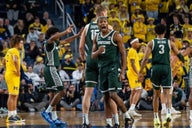
GO DEEPER
Michigan State and lessons from the old school
No. 9 St. John’s
St. John’s needs just one win in its final three to win at least a share of the Big East title. That means Rick Pitino will have now won the new iteration of the Big East to go along with his two league titles in the old iteration of the Big East. If you think of the new and old Big East as two different leagues, then Pitino will have won league titles in six different leagues (the SEC, Conference USA, the old Big East, the American, the MAAC and the new Big East). He also becomes the first coach in the Big East — old or new — to win the league in one of his first two seasons on the job. No one has done that since Jamie Dixon won in his first season at Pitt in 2004, and Dixon inherited a league champ from Ben Howland and had been on that staff. Pitino inherited a program that hadn’t won a league title since 1992!
Advertisement
After winning back-to-back league titles at Iona, this year would make three in the 2020s for Pitino, who has won multiple league titles in four different decades. Wouldn’t put it past him to make it five.
No. 16 Maryland
The consensus recipe for winning a national championship is having a top-20 offense and a top-20 defense in KenPom’s rankings. It matters where you finish, but there are currently six teams that rank in the top 20 in adjusted efficiency on both sides of the ball: Auburn, Duke, Florida, Houston, Arizona and Maryland.
Similar to Duke, it’s balance that makes the Terps so hard to guard. During their current four-game winning streak, their five starters have all scored in double figures in three of those games, and four of five hit double figures in the other win. Among teams in my top 25, Maryland is one of only two* — Ole Miss being the other — with all five current starters averaging double figures.
*Auburn has six guys averaging double figures, but two come off the bench, and Michigan was also in that group until Dusty May moved Roddy Gayle to the bench.
The Terps have quietly won eight of nine and are a team worth tracking as March approaches.
No. 19 Clemson
The Tigers rank eighth in Division I in 3-point percentage (38.8 percent), and all five starters shoot better than 36 percent from deep. On Saturday at SMU, Clemson started 7 of 8 from 3, and its first seven buckets were all 3s. The Tigers ended up tying their season-high with 14 3s. They’re one of those teams like Wisconsin that spreads you out and just keeps moving it, willing to turn down a good shot for a great one:
What’s wild is that for a team that leans heavily on 3s, they made only four in their biggest win of the season against Duke.
The ACC is having a down year, but we should still celebrate what Clemson is doing. The Tigers are 14-2 in conference and need just one more conference win to set a program-best mark.
Advertisement
No. 23 BYU
First-year coach Kevin Young’s goal was to bring his pick-and-roll concepts from the NBA to college, and after the first half of this season appeared to be a feeling-out period, BYU is starting to operate at an elite level.
After blowing out Kansas by 34 on Tuesday — which tied for the Jayhawks’ worst loss in the Bill Self era — BYU put up the highest points per possession against Arizona since the 2009-10 season (1.37).
The Cougars put on a pick-and-roll clinic with Young moving the pieces from the sideline. BYU got the Wildcats’ two best defenders (Jaden Bradley and KJ Lewis) off the ball by setting a guard-to-guard screen to create a switch and then going to the pick-and-roll set Young wanted:
Young also had his players picking on single-side tags. Ideally, the man in charge of tagging the roller is on the side of the floor with an extra defender, but thanks to BYU’s movement and the spots where the screens were getting set, Arizona often had its one-side man creeping toward the lane, and BYU took advantage:
The Cougars are so well-schooled that even just a step or two will signal a pass to the corner:
And the forced switch came in handy late when Arizona ended up switching everything, putting Caleb Love on Keba Keita, which gave Keita the advantage on the offensive glass:
This game ended with a controversial foul call — one reason I didn’t really ding the Cats on my ballot — but the Cougars’ performances last week should put the sport on notice. Young has a big name, image and likeness budget (see incoming No. 1 overall recruit AJ Dybantsa) and he’s proven with his first team that he knows how to smartly build for the college level. The pieces fit together with two elite rollers, plenty of shooting and two guards who thrive in making pick-and-roll decisions in freshman Egor Demin and junior Dallin Hall. The two point guards combined for 13 assists against the Cats and are arguably the best starter-backup combo at that position in college basketball.
BYU has now won four straight, and if you’re looking for a team that’s peaking late and could be a sleeper in the NCAA Tournament, this might be that team.

GO DEEPER
Meet the best passer in college basketball: ‘This is just joy’
No. 24 Saint Mary’s
The Gaels swept Gonzaga and will win the WCC for the third straight season and outright for the second straight. They’re heavy favorites in their final two games, which means they have a good chance to go 34-2 over the last two years in the WCC. Gonzaga has had similar two-year runs in the league, but adding to the significance of this run is that the WCC is playing 20 games for the first time and this might be the best the league has ever been with the additions of Oregon State and Washington State, plus Santa Clara and San Francisco operating as bubble teams.
Advertisement
What has separated Saint Mary’s from Gonzaga the last two seasons is its defense. The Gaels are allowing only 0.921 points per possession in conference play. No one else is under a point per possession.
Saint Mary’s is also eighth-best in adjusted defensive efficiency, meaning Randy Bennett’s team is on pace to finish in the top 20 in ADE for the fifth straight season. The only other teams that can make that claim? Houston, Tennessee and Kansas.
Dropped out: Kansas, UCLA.
Keeping an eye on: Creighton, VCU, Oregon, UC San Diego.
(Photo: Evan Bernstein / Getty Images)
This post was originally published on this site be sure to check out more of their content.


